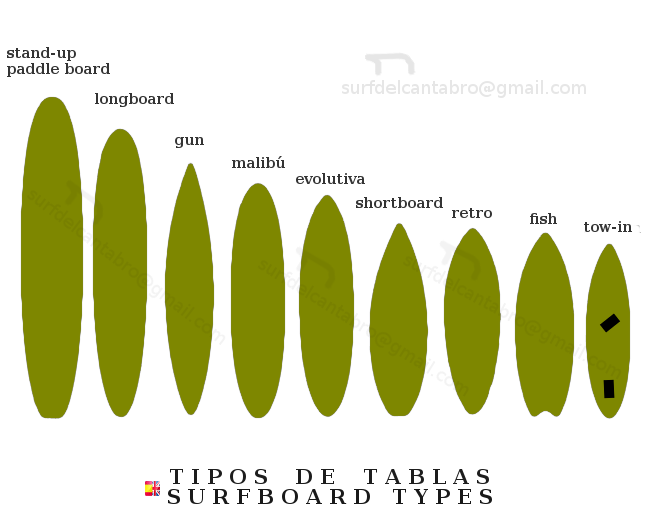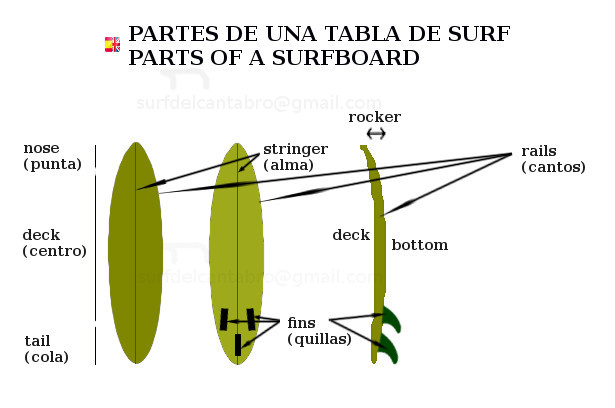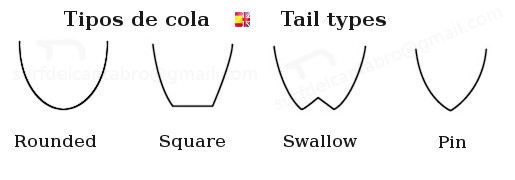Criterios para elegir una tabla de surf
![]() La elección de una tabla de surf esta determinada por varios factores: estatura, nivel del surfer, tipo de olas a surfear, etc. Son muchos los factores a tener en cuenta, y cada profesional que consultemos puede darnos nuevos matices que amplían nuestros criterios y abren un abanico más amplio de productos a elegir. Sin embargo lo más importante es acertar lo mejor para cada uno cuando vamos a elegir una tabla de surf.
La elección de una tabla de surf esta determinada por varios factores: estatura, nivel del surfer, tipo de olas a surfear, etc. Son muchos los factores a tener en cuenta, y cada profesional que consultemos puede darnos nuevos matices que amplían nuestros criterios y abren un abanico más amplio de productos a elegir. Sin embargo lo más importante es acertar lo mejor para cada uno cuando vamos a elegir una tabla de surf.
A continuación se da una breve guía, orientativa con los criterios más importantes.
Criterios :
- Medidas
- Tipos de tablas
- Partes de una tabla de surf
- Tipos de colas
1 – Medidas.
El sistema de medidas se rige por el sistema de medias inglés, que se da en pulgadas y en pies. 1 pulgada («) = 2,54 cm. 1 pie (‘) = 12 pulgadas.
- Altura : es la distancia total de la tabla , desde la cola hasta la punta. Esta medida debe estar en función de nuestra estatura. Una tabla larga facilita que podamos coger las olas y reduce la maniobrabilidad. En promedio la altura de la tabla debe superar en 30 cm nuestra estatura.
- Anchura : es la distancia medida de un canto de la tabla al otro en su parte más ancha. Aporta más estabilidad a la tabla dentro del agua conforme aumenta esta medida.
- volumen : es el grosor de la tabla en su cara superior (deck) y la inferior (bottom). Aporta flotabilidad a la tabla según aumenta su valor y disminuye la maniobrabilidad ya que la tabla se hace más pesada.
2 – Tipos de tablas.
![]()
![]()

![]()
Descripción :
- Stand-up, paddel board : son tablas diseñadas para ir de pie, y desplazarse o coger olas con ayuda de un remo. Son anchas, con buen volumen y de altura considerable. Son ideales para olas pequeñas y con poca fuerza.
- Longboard : tabla grande diseñada para un tipo de surf; donde prima la trayectoria y no la maniobra. Adecuada para olas pequeñas y medianas.
- Gun : su diseño hidrodinámico y afilado hace que sean tablas para olas grandes y coger velocidad, aportando estabilidad. Sólo adecuadas para surfers con buen nivel.
- Malibú : o minilongboard. Tienen una buena flotabilidad y mayor maniobrabilidad que los longboards. Indicada para iniciarse en el surf y para olas pequeñas.
- Evolutiva : es la mejor tabla para iniciarse en el surf. De maniobrabilidad , flotabilidad y estabilidad más que aceptables para princpipiantes.
- Shortboard : son versátibles, ya que ofrecen una relacción de alta calidad entre velocidad, estabilidad y maniobrabilidad. Son tablas que requieren un nivel técnico medio de surf.
- Retro : están inspiradas en los diseños de los años 70. Requieren un nivel medio de surf. Son indicadas para olas pequeñas y medianas con poca fuerza. Nunca para olas grandes.
- Fish : son tablas parecidas a las retro. requieren un nivel medio de surf. Son indicadas para olas pequeñas y medianas de mala calidad.
- Tow-in : son tablas diseñadas para surfear remolcados por una moto acuatica. Requieren un nivel medio-alto de surf.
3 – Partes de una tabla de surf.
![]()
![]()

![]()
Descripción :
- Punta (nose) : es el pico de la tabla. Lo importante es la anchura de la punta. A mayor ancho, mejor se cogen las olas, puesto que tiene más estabilidad.
- Centro (deck) : es la parte de la tabla sobre la que va el surfer.
- Tail (cola) : es la parte trasera de la tabla. Determina como la tabla se comporta ante la ola. A más anchura mayor maniobrabilidad, al contrario aumenta nuestro control sobre la tabla.
- Alma (Stringer) : es un pieza interna y fina de madera, que va desde la punta hasta la cola. Aumenta la dureza de la tabla.
- Bottom : parte inferior de la tabla que va en contacto con el agua.
- Cantos (rails) : son los bordes laterales de la tabla. Izquierdos y derechos, superiores e inferiores. A mayor anchura mejor flotabilidad, pero reduciendo la maniobrabilidad.
- Quillas (fins) : colocadas en la parte inferior de la tabla y de forma perpendicular. Aportan fluidez en las maniobra. Pueden ser fijas o intercambiables, lo cual nos ayuda si queremos adaptarnos a otra forma de surfear.
- Rocker : es la curvatura de la tabla. A mayor valor mejor maniobrabilidad pero con perdida de velocidad.
4 – Tipos de colas.
![]()
![]()

![]()
Descripción :
- Rounded : proporciona mayor acople a la ola. indicada para olas medianas y grandes.
- Square : tienen una buena maniobrabilidad y menor estabilidad. La evolución de este tipo de colas es el modelo squash; que consigue mayor estabilidad. Son adecuadas para olas pequeñas.
- Swallow : tienen buena maniobrabilidad y acople a la ola. Aptas para olas pequeñas.
- Pin : ofrecen un buen acople a la ola, perdiendo maniobrabilidad. Aptas para olas grandes.
Nota : compra una tabla acorde a tu nivel. Si tienes dudas entre varios modelos pide orientación antes de la compra y acercaté a una escuela de surf para comprobar lo escuchado y probrar las tablas. Por una pequeña cantidad puedes resolverte las dudas en una decisión que te va a acompañar durante varios años.
Criteria for choosing surfboard
![]() The choice of a surfboard is determined by several factors: height, level of surfer, type of waves to surf, etc. There are many factors to take into account, and each professional that we consult you can give us new nuances that extend our criteria and open up a wider range of products to choose from. However the most important thing is to guess the best for each one when we are going to choose a surfboard.
The choice of a surfboard is determined by several factors: height, level of surfer, type of waves to surf, etc. There are many factors to take into account, and each professional that we consult you can give us new nuances that extend our criteria and open up a wider range of products to choose from. However the most important thing is to guess the best for each one when we are going to choose a surfboard.
Below is a brief guide, indicative with the most important criteria.
Criteria :
- Measures
- Surfboard types
- Parts of a surfboard
- Tail types
1 – Measures.
The system of measures is governed by the English system, which is given in inches and feet. 1 Inch («) = 2.54 cm. 1 Foot (‘) = 12 inches.
- Height : is the total distance of the table, from the queue to the tip. This measure must be based on our height. A long surfboard makes it easier to be able to catch the waves and reduces the maneuverability. On average, the height of the surfboard has 30 cm over our stature.
- Width : this is the measured distance of an edge of the surfboard to the other at its widest part. Provides more stability to the surfboard inside the water, it increases according with this measure.
- volume : is the thickness of the table between its upper face (deck) and lower (bottom). It brings buoyancy to the surfboard. As increases, decreases its manoeuvrability due to the surfboard becomes more heavy.
2 – Surfboard types.
Surf types Picture : see above.
Description :
- Stand-up paddle board : these surfboards are designed to go on foot, and scroll or ride the waves with the help of an oar. them are wide, with good volume and of considerable height. Them are ideal for smaller waves and with little force.
- Longboard : large table designed for a type of surf; where the raw path and not the maneuver. Suitable for small and medium waves.
- Gun : its hydrodynamic design and sharp makes them surfboards for big waves. You can get speed with a good stability. Only suitable for surfers with good level.
- Malibu : or minilongboard. Them have a good buoyancy and greater maneuverability that longboards. Indicated to start in the surf and with small waves.
- Evolutionary : is the best surfboard to start in the surf. The manoeuvrability , buoyancy and stability for beginners is more than acceptable.
- Shortboard : them are versatibles, because them offer us a high quality of speed, stability and maneuverability. These surfboards require a medium technical level of surfing.
- Retro : them are inspired by the designs of the 70s. You must have a medium level of surfing. Are indicated for small and medium waves with little force. Never use for big waves.
- Fish : these surfboards are similar to the retro. You must have a medium level of surfing. Them are indicated for small and medium waves of poor quality.
- Tow-in : them are designed for surf towed by a jet ski. You must have a mid-high level of surfing.
3 – Parts of a Surfboard.
Parts of a Surfboard Picture : see above.
Description :
- nose : it is the peak of the surfboard. The main concept is the width of the tip. With higher values it will grab to the waves better, as it has more stability.
- deck : it is the part of the surfboard on which the surfer goes.
- Tail : is the rear of the table. Determines how the table behaves with the wave. When it is more width the board has greater maneuverability, on the contrary it increases our control on the table.
- Stringer : it is an internal and fine wood part which goes from the nose to the tail. Increases the hardness of the surfboard.
- Bottom : is the side of the surfboard that is in contact with water.
- rails : them are the side edges of the surfboard. Left and right, upper and lower. With a greater width of them you will have better buoyancy, but you will reduce the maneuverability.
- Fins : them are placed at the bottom of the table and perpendicular. Them give to the surfboard more fluidity in the maneuver. Them can be either fixed or interchangeable which helps us to surfing with another style.
- Rocker : is the curvature of the table. The higher the value better maneuverability but with loss of speed.
4 – Tail types.
Tail types Picture : see above.
Description :
- Rounded : it provides greater grip to the wave. Suitable for medium and large waves.
- Square : it have a good manoeuvrability and less stability. The evolution of this type is the squash type; that achieves greater stability. They are suitable for small waves.
- Swallow : it have good maneuverability and grip to the wave. Suitable for small waves.
- Pin : it offer a good coupling to the wave, losing maneuverability. Suitable for big waves.
Note : you should purchase a surfboard according to your level. If you have doubts among several models requests guidance prior to purchase. You can go to a surf school to verify what has been heard . You can rent it by a small amount and that would avoid any future insatisfaction.
![]()